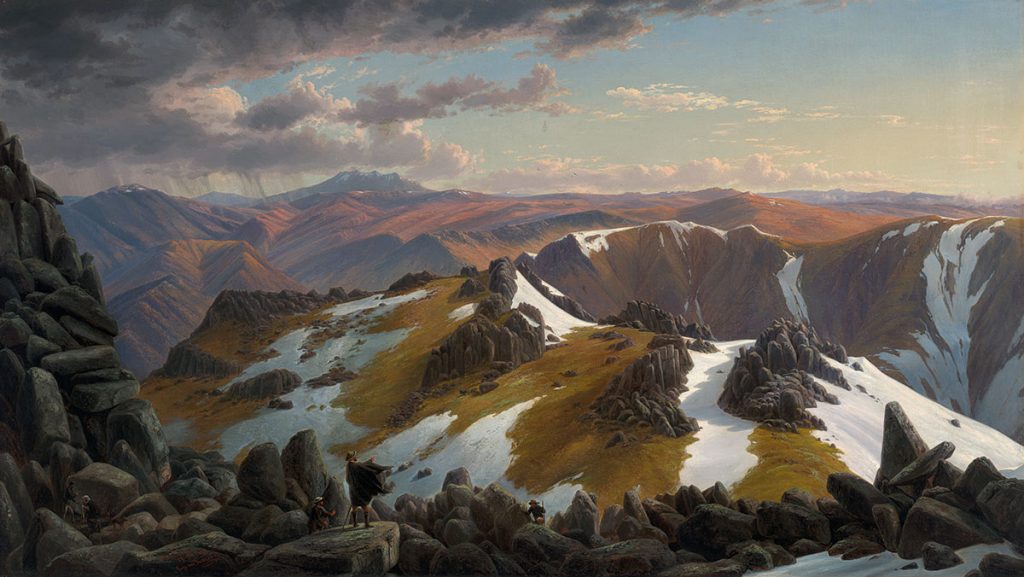The sky had a ‘threatening look’ about it when Georg von Neumayer and his party reached the summit of Mount Kosciuszko on the morning of 19 November 1862. Neumayer, a Bavarian scientist of exacting standards, was conducting a geomagnetic survey of Victoria, a colony which, under the influence of Governor Charles La Trobe, avidly supported the advancement of science and the arts. Travelling as a private guest of Neumayer was the Vienna-born painter of Romantic landscapes, Eugene von Guérard. This was to be expected, for artists had regularly accompanied scientific expeditions since the explorations of Captain Cook.
That morning, von Guérard was sketching a panoramic view of Kosciuszko’s summit across two pages of a leather-bound memorandum book, first in pencil, then adding details and highlights with ink. It was a tiny book, only six inches by three and three-quarter inches in size, already filled with equally diminutive landscapes that demonstrated von Guérard’s limitless patience for detail. This trait was inherited from his father, a painter of portrait and landscape miniatures in the royal courts of Europe.
Although it was November, snowdrifts still lay about the peak and could be seen covering nearby summits. After lunch (during which the expeditionary team drank to the artist’s health, it being his 51st birthday) von Guérard was seated on the summit, when he called out to Neumayer ‘that it appeared… a heavy storm was approaching from the New South Wales side’. Neumayer watched the plummeting air-pressure on his barometer. In his published account, Results of the Magnetic Survey of the Colony of Victoria, Neumayer later recalled how this convinced him ‘that there was no time to be lost’, whereupon he called out for everyone to return to camp, seven miles distant, as quickly as possible. It was 2.25pm when they commenced their descent.
Reaching the foot of the summit, Neumayer remembered that maps had been left behind on one of the peaks, and so he sent one of his assistants, Edward Brinkmann, to collect them. Brinkmann set off with the party’s dog, Hector, trailing in his wake. Within five minutes the stormfront hit, engulfing the mountain in dense cloud and torrential rain. Neumayer called out for Brinkmann, but visibility was almost zero, and only the dog returned.
It was 8pm by the time only Neumayer and von Guérard finally located the party’s camp lower on the mountain, where everything was ‘wet through and torn’. Having achieved this, the pair then went back to search for their guide, John Twynham, whom they found about half a mile away. Twynham was ‘quite stiff and unable to move’, so they carried him back to camp. As Brinkmann had the party’s matchbox, it took 90 minutes of intense fiddling before a fire was lit. Inside their tent, the men heard ‘the roaring of the wind interrupted occasionally only by thunder’. It was past 11pm when Hector’s barking announced the return of another one of the missing men, Weston. Neumayer’s delight ‘[could] scarcely be imagined’.
The following morning on the summit, Neumayer found, untouched, the maps he had asked Brinkmann to retrieve. After a day’s rest, the party left provisions and instructions for Brinkmann, should he return to camp. They gave ‘three cheers for the missing man’, and descended the mountain. The next 16 days were spent traversing the Australian Alps, first from Tom Groggin Station to Omeo (where bushfires lit up the sky in every direction, and where they raised the alarm for a search party), pushing on to Mount Feathertop, and through the gold towns of Bright and Buckland to Yackandandah.
The party arrived in Belvoir (Wodonga) on 6 December, and headed straight for the police court where they hoped to find Edward Brinkmann, but there was no sign of him ‘so that the last hope of his safety was now quite destroyed’. With heavy hearts, the men sat down to dinner and ‘had hardly done so, when the lost man made his appearance in the most deplorable condition’. After the storm on Mount Kosciuszko, Brinkmann had wandered for two days until he fell in with a gold miner who took him to the alpine gold-rush town of Kiandra, a bewildering 45 miles north of Kosciuszko as the crow flies. From Kiandra he had worked his way to Wodonga. It was a remarkable story of survival and good fortune, and as von Neumayer would reflect, the epitome of ‘courageous behaviour’.
The painting von Guérard produced from the sketches of that day in 1862 when Edward Brinkmann barely escaped with his life, was North-east view from the northern top of Mount Kosciusko (1863). Echoing the great works of German Romanticism, the accuracy with which von Guérard depicted the landscape wasn’t a matter of mere scientific record; it was also an attempt (as the great German scientist Alexander von Humboldt had said of his own work) to ‘grasp nature’s essence under the cover of outer appearances’. In the painting, von Guérard portrays himself and the men with whom he’d travelled as observers who can only gesture at and clambor about this sublime landscape. Dwarfed by the mountains, their tiny figures remind us of the fleeting and precarious nature of human existence when compared with the enduring presence of nature. Together with his companions, von Guérard had witnessed nature’s almighty power. In North-east view from the northern top of Mount Kosciusko there is absolutely no doubting the artist’s profound appreciation of the Australian landscape, which to him was surely the work of God.
The Ian Potter Centre: NGV Australia
Federation Square, Swanston Street
Melbourne, Victoria
Eugene von Guérard
Born Austria 1811, lived in Australia 1852–82, Europe 1882–1901, died England 1901
North-east view from the northern top of Mount Kosciusko 1863
oil on canvas 66.5 x 116.8 cm
National Gallery of Australia, Canberra.
Purchased 1973



Comments are closed.